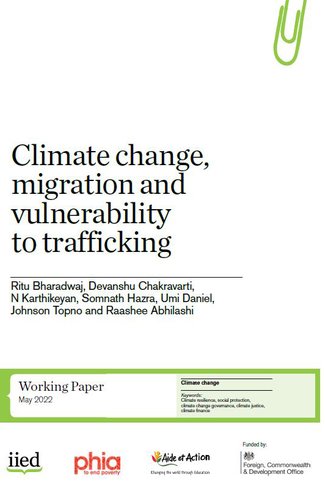Climate Change, Migration and Vulnerability to Trafficking (Jharkhand, India)
2022
- Author
- Bharadwaj R, Chakravarti D, Karthikeyan N, Hazra S, Daniel U, Topno J and Abhilashi R (IIED)
- World region
- South Asia
- Origin of migration
- Jharkhand region, Palamu district in India
- Area of transit
- No data available
- Destination of migration
-
North India.
Punjab, Bihar, Haryana, Delhi, Rajasthan, Mumbai, Kerala, Raipur and Bangalore. - Who is affected
- Girls, Men, Women
- Type of climatic event
-
Slow-onset event
Droughts were cited as the major climate-related stressor by respondents in the study, followed by floods, soil erosion and storm surges. The trend of declining and irregular rainfall has intensified. Climate change events result in loss and damage, reducing household income. They also impact the availability of forest resources and water, harming people's livelihood opportunities and means of survival.
- Type of migration/mobility
-
Internal (but intra-state), Rural to urban, Seasonal
The Jharkhand region is characterised by short-term seasonal and temporary migration. Education levels appear not to play a role in migration. In Palamu, people also migrate to work at brick kilns. Women migrate to work in garment factories. People mostly migrate for work, but also to access healthcare and alleviate household debt.
- Destination industry or sector
-
Agriculture, Brick kilns, Commercial sexual exploitation, Domestic work, Manufacturing
*Agriculture (forced labour), forced commercial sexual exploitation (human trafficking)
- Type of modern slavery
-
Debt bondage, Forced labour, Human trafficking
Traffickers typically target children between the ages of 11 and 16, because they are unlikely to report exploitation.
- Link between climate change, migration and modern slavery
- Indirect
- Key vulnerability factors
-
Extreme events cause shocks that affect the livelihoods of the local community. Survey results show that households lose money due to crop, livestock and equipment damage and loss of life caused by extreme events. Vulnerability to human trafficking is increased by food insecurity and other socio-economic challenges, such as unemployment and lack of resources. Debts incurred to fund migration can also contribute to higher vulnerability.
- Summary
-
This report explores the links between climate change, migration and human trafficking in two distinct areas in India, one affected by slow-onset events and one by rapid-onset events. It finds that climate change has become a new driver of migration and human trafficking. When migration occurs under distress, people are at greater risk of human trafficking. More research is needed on the factors that expose people to human trafficking, why they are pulled towards unsafe migration routes and gaps in social protection during climate events.
- Recommendations
-
Recommendations at the sub-national, national and international level highlight the importance of adaptation solutions for local communities, safe migration options, access to social protection and safety nets, the consideration of human trafficking in development planning, and local research and evidence.



